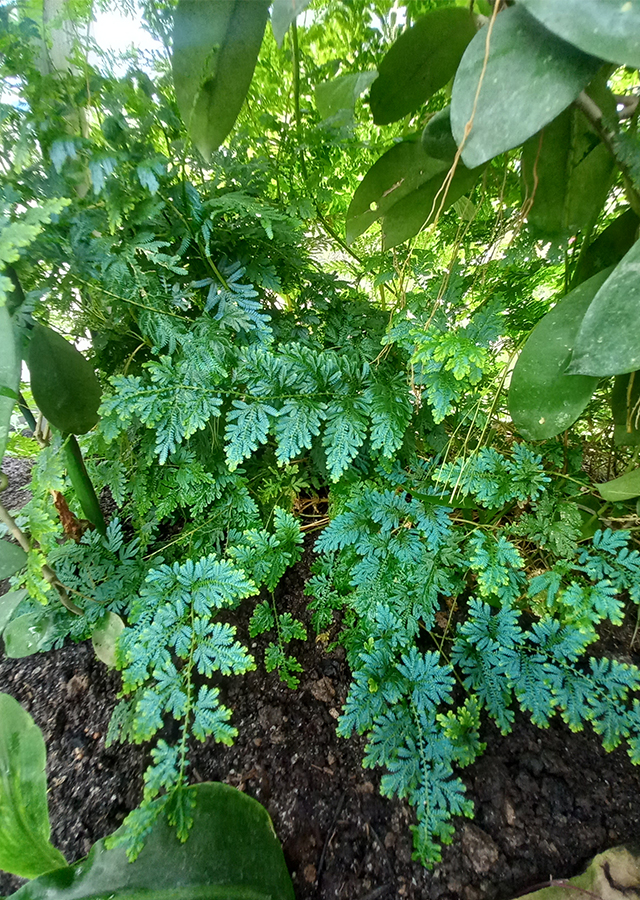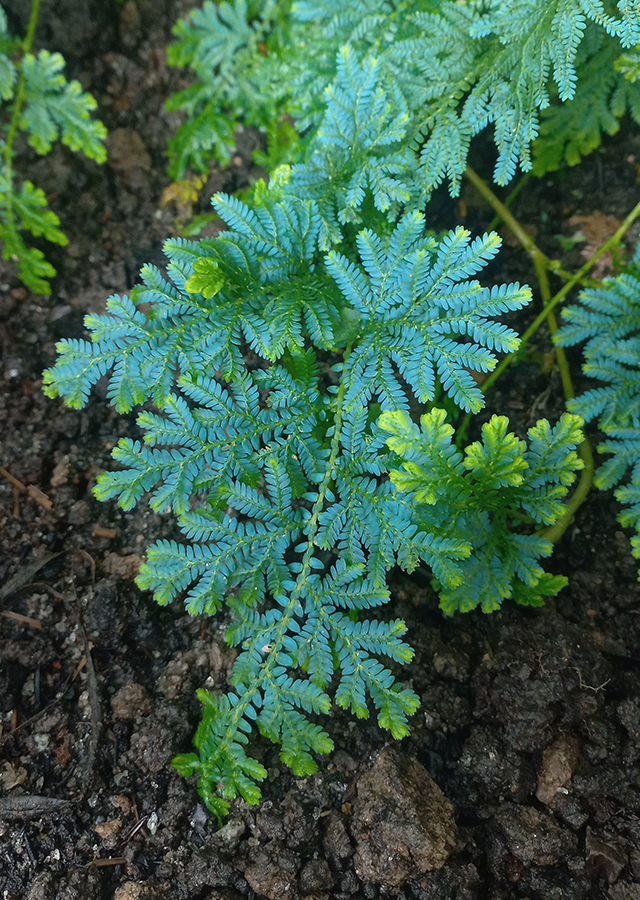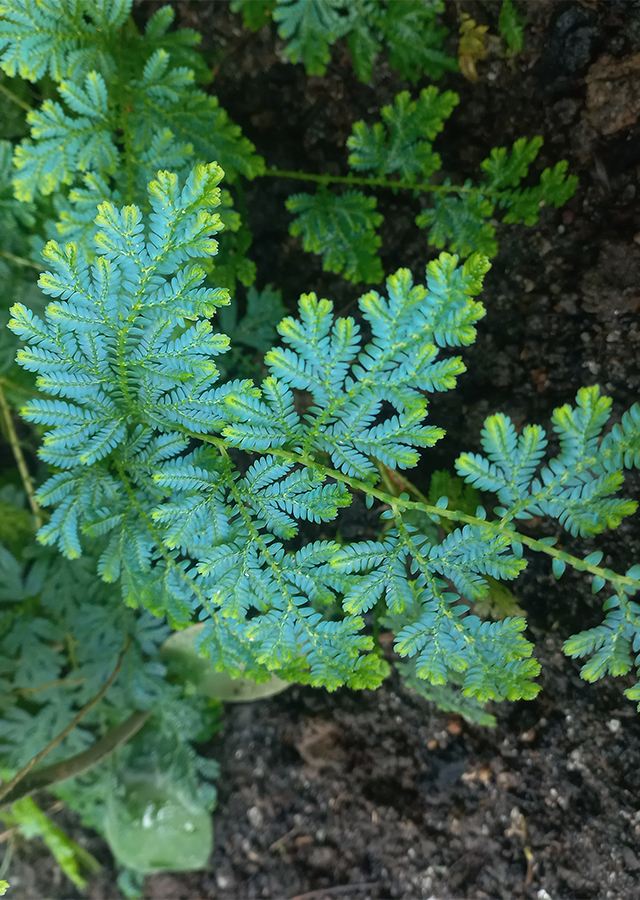Willdenow’s Spikemoss
Selaginella willdenowii (Desv.) Baker
Selaginellaceae
Location in our garden
Principal



Synonym
Lycopodium willdenowii Desv.
Habitus
Fern. An evergreen perennial creeper fern that grows 1-2 m tall
Part Used
Leaves
Stem
Rhizome
Growing Requirements
Need Shade
Habitat
Forest
Overview
Selaginella willdenowii is native to Malaysia, Indonesia and Myanmar, and introduced to Colombia, Florida, Jamaica, Panamá, Puerto Rico, and Queensland. Genus Selaginella is derived from the Latin word selago, which means clubmoss. Species willdenowii is most likely named in honor of Carl Ludwig von Willdenow (1765 - 1812), who was a German naturalist and physician, Director of Berlin Botanical Garden and author of Flora Berolinensis prodromus (1787). It is used as traditional medicine and vegetable in some Asian countries.
Vernacular Names
Teng juan bai (Chinese).
Agroecology
Found naturally on the forest floors, under shrubs; below 100-1,000 m, its preference for low light and moist conditions makes Willdenow’s Spikemoss a suitable house plant and good groundcover in shady conditions.
Morphology
- Roots - uderground fibrous roots.
- Rhizophores - restricted to lower part of main stem or up to upper part, with some spinelike protuberances at base (as well as at axes of stems).
- Stem - main stems branched from near base upward, stramineous or reddish, 2.4-3.5 mm in diam. in lower part, angulate, sulcate, glabrous. Primary leafy branches 5-15 pairs, 3 times pinnately branched, ultimate branches simple or forked, branchlets sparse and regular, adjacent primary branches on main stem 6-13 cm apart, ultimate branches 3-7 mm wide including leaves.
- Leaves - axillary leaves on main stems obviously larger than those on branches, oblong, biauriculate. Axillary leaves on branches symmetrical, oblong or oblong-elliptic, 1.5-2.4 × 1-1.6 mm, base biauriculate, margin entire. Dorsal leaves asymmetrical, those on main stems obviously larger than those on branches. Dorsal leaves on branches approximate to imbricate, overlapping at leaf apex, falcate, 0.9-1.4 × 0.4-0.6 mm, not carinate, base obliquely subcordate, margin entire, apex obtusely cuspidate. Ventral leaves asymmetrical, those on main stem obviously larger than those on branches. Ventral leaves on branches slightly ascending or spreading, distant or approximate, oblong-falcate, 2.8-4 × 1-1.5 mm, margin entire, apex obtuse. Acroscopic base with rounded auricle, not overlapping stem and branches.
- Strobili - solitary, terminal, compact, tetragonal, 5-35 × 1.8-3.8 mm. Sporophylls unlike sterile leaves, uniform, white-margined, suborbicular, margin entire, apex acute or cuspidate. Megasporophylls in middle on lower side of strobilus. Microsporangia orbicular, rather thin, cells regular. Microspores pale yellow, megaspores whitish.
Cultivation
- Generatively propagated by spores.
- Vegetatively propagated by stem cutting and division.
Chemical Constituents
Alkaloids, terpenoids, phenolic compounds (flavonoids [isocryptomerin, 4',7''-di-O-methyl-amentoflavone, bilobetin, 2'',3''- dihydro-isocryptomerin, robustaflavone, 7''-O-methyl-robustaflavone], tannins, saponins).
Traditional Medicinal Uses
- It is depurative or stomachic.
- In Indonesia, it is used in decoction as a protective medicine after childbirth and as an ingredient of tonic as well as to treat skin disease such as itches and ringworm, to treat wounds and menstrual pains.
- In Malaysia, leaf decoction is used to treat wounds, high fever and backache, as well as being used as tonic medicine.
- In Brunei, it is used to treat gastric pains and infections of urinary tracts.
- In India, leaf infusion is administered to treat high fever and its ashes are used as liniment for backache.
Part Used
Reference Sources
- Adnan, M. et al. (2021). Evidence-Based Medicinal Potential and Possible Role of Selaginella in the Prevention of Modern Chronic Diseases: Ethnopharmacological and Ethnobotanical Perspective. ACG Publications. Rec. Nat. Prod. X:X (2021) XX-XX. DOI: http://doi.org/10.25135/rnp.222.20.11.1890.
- Chai, Tsun-Thai Chai, and Wong, Fai-Chu. (2012). Antioxidant properties of aqueous extracts of Selaginella willdenowii. Journal of Medicinal Plants Research Vol. 6(7), pp. 1289-1296. Also available online: http://www.academicjournals.org/JMPR DOI: 10.5897/JMPR11.1376 ISSN 1996-0875 ©2012 Academic Journals.
- Flora Of China. (No date). Selaginella willdenowii. http://www.efloras.org/florataxon.aspx?flora_id=2&taxon_id=233501249. 28-08-2022.
- Kew Royal Botanic Gardens. (No date). Plants of the World Online: Selaginella willdenowii (Desv.) Baker. https://powo.science.kew.org/taxon/urn:lsid:ipni.org:names:60471496-2#synonyms. 28-08-2022.
- National Park of Singapore. (2022). Flora Fauna Web: Selaginella willdenowii (Desv. ex Poir.) Baker. https://www.nparks.gov.sg/florafaunaweb/flora/1/5/1578. 28-08-2022.
- Setyawan, A. D. (2009). Traditionally utilization of Selaginella; field research and literature review. N U S A N T A R A B I O S C I E N C E, Vol. 1, No. 3, pp. 146-158. DOI: 10.13057/nusbiosci/n010307.


